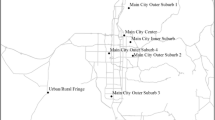Summary and Conclusions
This study examines the influence of the spatial structure of city locations on air travel by considering the factors of intervening opportunities and the hierarchical system of cities in addition to the simple dimension of distance. The statistical results show that the familiar strength of the gravity model is matched by that of the intervening opportunities model, but only when all cities are analyzed together. The disaggregation of cities by size and region (hierarchy) leads to a spotty performance by both models. The generality of the gravity and intervening opportunities models is thus called into question, and the potency of the hierarchical city organization as a contributing influence determining air traffic flows is demonstrated.
Similar content being viewed by others
References
Anderson, T. R., “Intermetropolitan Migration: A Comparison of the Hypotheses of Zipf and Stouffer,”American Sociological Review, Vol. 20, pp. 287–291 (1955).
Carrothers, G. A. P., “An Historical Review of the Gravity and Potential Concepts of Human Interaction,”Journal of the American Institute of Planners, Vol. 22, pp. 94–102 (1956).
Domestic Origin Destination Survey of Airline Passenger Traffic, Ten Percent Sample from January 1 to December 13, 1960, Vol. 1–13, Airline Finance and Accounting Conference.
Long, W. H., “Airline Service and the Demand for Intercity Air Travel,”Journal of Transport Economics and Policy, Vol. 3, pp. 287–299 (1969).
Long, W. H., “City Characteristics and the Demand for Interurban Air Travel,”Land Economics, Vol. 44, pp. 197–204 (1968).
Neidercorn, J. H. and B. V. Bechdolt, Jr., “An Economic Derivation of the 'Gravity Law' of Spatial Interaction,”Journal of Regional Science, 9 (1969), pp. 273–282.
Philbrick, A. K., “Areal Functional Organization in Regional Geography,”Papers and Proceedings ofthe Regional Science Association, Vol. 3, (1957).
Stouffer, S. A., “Intervening Opportunities: A Theory Relating Mobility and Distance,”American Sociological Review, Vol. 5, pp. 845–867 (1940).
Uris, R. B., “Distinguishing Between Distance and Intervening Opportunity in a Gravity Model Study of Interurban Air Travel,” Masters Essay, Economics Department, The Pennsylvania State University, (1968).
Whitten, C. A.,Airline Distances Between Cities in the United States, Washington, D. C.: U. S. Department of Commerce, Coast and Geodetic Survey, Government Printing Office, (1947).
Author information
Authors and Affiliations
Rights and permissions
About this article
Cite this article
Long, W.H., Uris, R.B. Distance, intervening opportunities, city hierarchy and air travel. Ann Reg Sci 5, 152–161 (1971). https://doi.org/10.1007/BF01288120
Issue Date:
DOI: https://doi.org/10.1007/BF01288120




